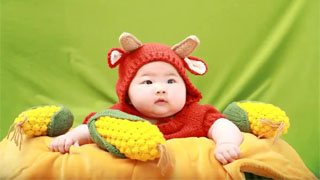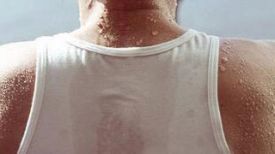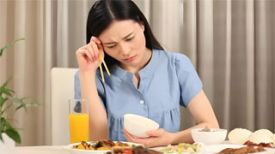
Article excerpt: "Traditional Chinese Medicine Ancient Methods for Infant and Child Health Preservation"
Pneumonia is known as the number one killer of children's health among common illnesses, especially for young children, especially infants under one year old, who are prone to severe pneumonia.
The external manifestations of pneumonia are actually similar to the early stages of a cold and coughing. At the beginning, there is a slight fever, followed by coughing, but the progression of pneumonia will be deeper than the first two diseases. Generally, children have a mild cough, and if it becomes more severe, they may hear the sound of phlegm in their lungs, which is a relatively wet sound.
But if it's pneumonia, coughing can also be accompanied by shortness of breath. The child's nose will stir, the nostrils will stir, and breathing will be rapid. Moreover, the phlegm he coughs out is very sticky and the sound of phlegm is very loud, indicating that there will be more exudate in the lungs. Another characteristic is that severe children may experience symptoms similar to suffocation, with blue lips and pale faces, which is a sign of severe pneumonia and life-threatening conditions.
From the perspective of traditional Chinese medicine, the treatment factors for pneumonia are very simple. There are two reasons: the first is external factors, which are external wind pathogens. Wind pathogens, just like we used to talk about colds, include wind cold and wind heat, both of which can cause pneumonia. The other is internal factors, which are insufficient lungs and spleen. Some children are born naturally, while others may be acquired later in life. Improper feeding by adults, in traditional Chinese medicine, can lead to weakened bodies and increased susceptibility to this disease.
The ancients said, 'To ensure the safety of a child, there are three parts: hunger and cold.'. Nowadays, life is better and nutrition is more abundant, but there are many children with lung heat. The heat in the lungs can be seen from the appearance of children: their faces are always red, and when they stick out their small tongues, they are particularly red. The tongue coating is quite thick, and some are quite greasy. Their lips are red, so if these children have a slight cold, they are prone to lung infections, followed by coughing, and combined with other infections, they may get pneumonia.
Such children need to heat up and avoid giving them high calorie foods frequently. Another thing to note is not to switch between hot and cold. For example, during the spring and autumn seasons, it is important to pay attention to adding or removing clothes for children. Alternating between hot and cold can easily lead to infections, colds, and ultimately pneumonia.
Here are some experiences in traditional Chinese medicine diagnosis and treatment of pneumonia at the beginning, for reference by Chinese medicine professionals. For parents and friends who are not majoring in traditional Chinese medicine, if your child has pneumonia, it is recommended that you take them to the hospital for diagnosis and treatment as soon as possible.
Wind cold closed lung pneumonia
The combination of cold air and wind can damage lung qi, causing shortness of breath and coughing in wind cold closed lung pneumonia. Also, they are afraid of the cold and don't sweat much. These are all manifestations of wind chill. The other one has phlegm, but the color of the phlegm is white and clear. Some may have mucus, which is also clear. Not thirsty in the mouth, not red in the tongue.
Dietary therapy method: Onion ginger almond soup
Three sections of scallion white, five pieces of ginger, five to ten grams of almonds, a handful of rice, some water to boil together, after boiling, until the rice Congee is cooked. Drink while it's hot, preferably to make you sweat.
Wind heat closed lung pneumonia
The symptoms of this pneumonia, as long as it is of the wind heat type, have a particularly dry mouth and a strong desire to drink water, but no amount of it can quench thirst. The child's body is a pure yang body, which is easily prone to heat up. His innate energy is also abundant, and the first step is wind cold, which quickly transforms into wind heat.
Dietary therapy method: Mulberry Apricot Gypsum Soup
Mulberry leaves, almonds, gypsum, and glutinous rice. Mulberry leaves and almonds each 5 grams to 10 grams, put more gypsum, 20 to 30 grams, japonica rice is 50 grams, cooked together into Congee to drink. After drinking it, you will feel particularly moisturized and thirst quenching. Try to give your child plenty of it, as it is very comfortable to drink. Sweat will be expelled as soon as possible, and lung heat will be released, leading to a good transformation of the body.
It should be noted that gypsum tends to be cold, and if consumed for a long time, it can easily damage the stomach, so it should not be consumed for a long time. The longest course of pneumonia is 14 days, or as short as 7 days. Drinking for 3 to 5 days is sufficient.
Nursing care for children with pneumonia
1. Rest.
Rest is important because when a person is quiet, it nourishes their yin, and when their limbs are active and flowing, it nourishes their yang energy. Because the lungs belong to the Hand Tai Yin Lung Meridian, which is the Yin Meridian, it is necessary to restrain the Yin Qi. Nourishing Yin, including nourishing the liver, kidneys, and lungs, requires good rest, especially sleep. Do not talk too much. Children like to play, make noise, and shout loudly. Do not let them do this.
2. Diet.
Make some delicious meals and drink more Congee because it is easy to digest. You can cook porridge with 30g lily, 50g yam and 50g to 100g japonica rice to nourish your lungs.
3. Air circulation.
Keep the air circulating, adjust the temperature and humidity well, and avoid being too dry. If it is too humid, it is also not acceptable. It is better to have a humidity of 60%.
4. Timely remove respiratory secretions.
Especially for very young children who cannot cough up phlegm on their own, you need to change their position, pick them up and pat them, and the phlegm will come out.
5. Drink plenty of water.
Drink plenty of water, and after urinating too much, it will be discharged.
6. Isolation.
Once a child shows initial symptoms, do not go to public places, do not send them to kindergarten to avoid infecting other children, and do not come into contact with other children who have caught a cold. It is necessary to isolate them well.
Prevention of pneumonia
Firstly, it is about seasonal prevention. Winter and spring are the high incidence seasons for pneumonia. Due to the large temperature difference, it is important to keep warm and avoid catching a cold.
2. Participate in more physical exercise to enhance physical fitness.
During the flu season, do not go to public places, including subway stations, shopping malls, and emergency rooms in hospitals. These are usually places where bacteria are more concentrated. If it is necessary to go, it is best for both adults and children to wear masks.
Disclaimer: This article is a sharing of health knowledge. The drugs, prescriptions, acupuncture and moxibustion and other treatment and health preserving methods mentioned in this article should be applied under the guidance of professional doctors, and should not be applied by yourself. We are not responsible for any issues arising from improper use.


